The Rise and Fall and Rise of the Polaris SKS
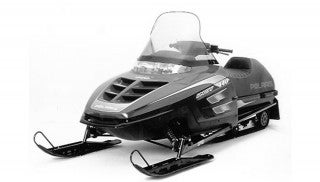
Original SKS launched the deep powder sled market
If you stay with a thing long enough, you may see it through various iterations of itself. That’s how we feel about the Polaris SKS, new for model year 2016.
The return of the SKS, which was born as the “Snow King Special” resonated with riders who wanted a bit of extra track length and flotation for running in the mountains. Or, breaking trail in ungroomed areas of the Midwest and East. But, figure that the SKS grew from the fact that Polaris recognized the western powder areas with their unique competitions as a new and growing market to conquer.
There were racing circuits in the Rocky Mountains where riders rode off into the hills, virtually creating their own trails to see who was fastest from point to point. Arctic Cat created a series of “powder specials” and supported these racers with factory backing. Polaris learned that helping riders of their sleds get over the top at various hillclimbs actually resulted in additional sales. One of the most prominent hill climbs was held in Jackson Hole, Wyo., on a ski run at Snow King Mountain. It was a great place for Cat and Polaris to battle. Spectators would line the hillside and marvel as riders and sleds attempted to blast over the top, but too often crashing with their sleds careening out of control back to the bottom. It was exciting and emblematic of the wild west.
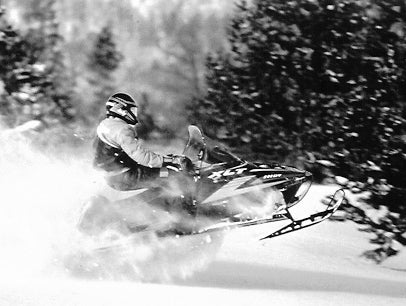 Before the RMK series, Polaris conquered deep powder with its extended track SKS models, including the “Xtra Light Triple” XLT version.
Before the RMK series, Polaris conquered deep powder with its extended track SKS models, including the “Xtra Light Triple” XLT version.We don’t anticipate the 2016 Polaris SKS reliving that early history, but it does have quite a legend surrounding the name. The first SKS versions of the Polaris Indy were little more than extended length Indys. As the factory gained experience, SKS variants included tracks with 130-plus lengths versus the 120 or 114 inch lengths that were common in the 1970s and 1980s. The popular hill climb models evolved from the Indy 400 and peaked with the Polaris-built 800cc two-stroke twin. Of course, by the time those engines made their way to the SKS, they were more common to the SKS replacement, the Rocky Mountain King (RMK).
A bit ironic that the SKS, which originally spun off the RMK, is now a spin-off of the latest RMK series. By model year 2003, Polaris emerged as a powder sled leader. In additon to the Indy SKS models, the company fielded various RMK versions, which included a special Vertical Edge package with a deep snow performance Series 4 track, special Sidehiller 2 skis and graphics treatment.
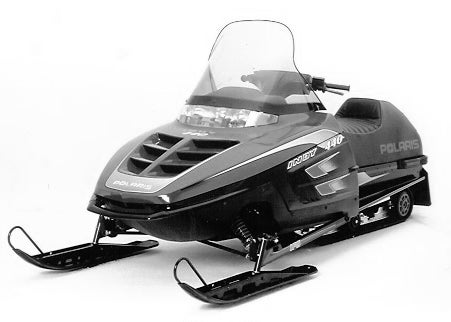 Based on the EDGE platform, the Polaris 440 SKS featured a “long” 144-inch track and power from a liquid-cooled 440 twin.
Based on the EDGE platform, the Polaris 440 SKS featured a “long” 144-inch track and power from a liquid-cooled 440 twin.In 1988 Polaris offered an Indy Trail SKS model that featured the fan-cooled Fuji-built 488cc two-stroke twin. By the start of the next century, the 488cc Indy Trail SKS would be replaced by a 544cc two-stroke twin and RMK designation. Model year 2003 saw a virtual phasing out of the SKS in favor of the RMK nomenclature. Why not? The RMK had grown to include a suite of the most popular and powerful Polaris two-strokes, including the Liberty 600, 700 and 800 liquid-cooled twins. In 2003, the only SKS models left were the Indy 700 SKS and the Indy 800 SKS, which Polaris noted were built “for any and all riding conditions.” The standard track was a 15-inch wide by 144-inch length. Lug height for the SKS topped out at 1.25 inches.
You could easily discern that the RMK was the model of choice. There were many more options in the RMK series. You could opt for the fan-cooled Trail RMK with the 136-inch length up to the 159-inch track with two-inch lugs that was offered on the Vertical Escape.
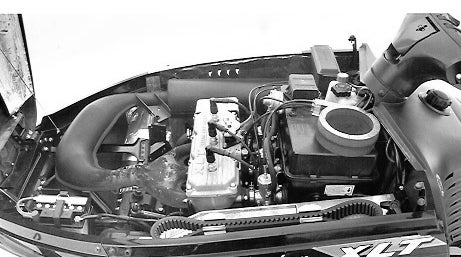 The Polaris Xtra Light Triple was a good all-around motor but it came out just as the other sled makers were committing to big bore twins.
The Polaris Xtra Light Triple was a good all-around motor but it came out just as the other sled makers were committing to big bore twins.Snowmobile manufacturers accepted the western snowmobiler as a viable, if somewhat unique, market niche. This was fortunate for the industry, as inconsistent snow devastated the Midwest and Eastern portions of North America, leaving the mountain west as the only consistent area for sled sales. Until recently that pattern has held and explains why snowmobile manufacturers have launched more innovative products in that region. The western rider demands lighter weight sleds with greater horsepower and the sled makers have responded.
Polaris brought the weight of its long tracked mountain sleds down to just over 400 pounds. All but Yamaha offer high horsepower 800cc two-stroke engines, a move directly related to those rider demands. Polaris created a special drive system for its Pro-RMK, while Ski-Doo invented a “swing-action” tMotion rear suspension to give its 174-inch long, three-inch paddle track greater grip for hillclimbing and backcountry play.
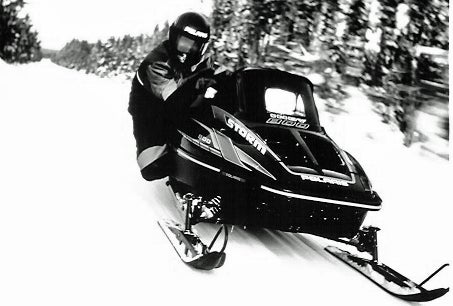 Where the XLT triple featured a single head, the Storm triple went with individual heads and greater performance to power the Storm SKS.
Where the XLT triple featured a single head, the Storm triple went with individual heads and greater performance to power the Storm SKS.Interestingly, Polaris history seems to be coming full circle now. The Pro-RMK evolutions are being used in a new Polaris SKS, that features a high horsepower Polaris-built 800cc twin powering a 155-inch track length. As with the 2003 Indy 800 SKS, the current version sports a newer chassis and top of the line shock package. Where the 2003 SKS offered an adjustable 41-inch to 42.5-inch ski stance, the 2016 SKS offers three adjustments from 39 to 40 to 41 inches.
Another similarity between the old and new should be in where the SKS sells best. By the early 2000s, Polaris acknowldeged that the SKS was not a mountain sled and that it was best suited for Midwestern and Eastern riders where it performed well in “lake effect” snow areas like Michigan and Ontario. The same can be said for the born-again 2016 SKS.
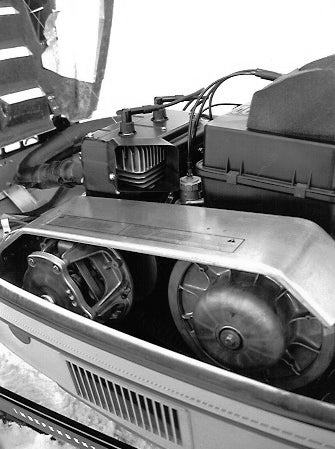 The “base” Trail SKS model utilized a modest fan-cooled twin and a shorter 136-inch track length.
The “base” Trail SKS model utilized a modest fan-cooled twin and a shorter 136-inch track length.If you have checked the various Polaris and Ski-Doo specifications for this model year, you will have discovered that Ski-Doo, in particular, makes a point of fitting some of its models with performance packages best suited for elevations less than 8,000 feet. Present-day snowmobile makers accept that not all of their “mountain” sleds will be used at elevation, but those riders still want the handling and floation of the mountain set up. Plus, they want the option of taking that sled to the mountains for a vacation week of deep powder riding.
How does a snowmobile maker satisfy such rider needs? Well, in Polaris’ case, reinvent the SKS. It may be a stretch to say that the SKS launched the deep powder sled market, but probably not by much. Now what was old is new again. Welcome to the revolution.
| 2003 Polaris 800 SKS | 2016 Polaris 800 SKS 155 | |
| Engine | Polaris Liberty two-stroke high-performance 794cc; two-cylinder, liquid-cooled; 2x40mm Mikuni slide carbs; case reed; digital CDI | Polaris Cleanfire two-stroke high-performance 795cc; bore/stroke of 85mm/70mm; two-cylinder, liquid-cooled; Cleanfire electronic fuel injection system |
| Horsepower | NA | 155+ |
| Drive | Chaincase drive with Polaris driver and driven | Chaincase drive with Polaris P85 driver and TEAM LWT driven |
| Front Suspension | Polaris EDGE SKS controlled roll center, trailing-arm; RydeFX shocks; up to 7.8-in of travel; dual runner Sidehiller 2 skis | AXYS RMK adjustable A-arm; Walker Evans piggyback shocks; up to 9-in of travel; Gripper skis |
| Rear Suspension | Polaris EDGE RMK parallel dual purpose slide rail; RydeFX gas shocks; up to 17-inches of travel | Polaris parallel slide rail RMK Coil-Over; Walker piggyback gas shocks; up to 16-inches of travel |
| Length | 120.0 in | 131.0 in |
| Height | 48.0 in | 49.125 in |
| Width | 47.5 in | 46.5 in |
| Ski Stance | Adjustable 41-42.5 in | Adjustable 39-40-41 in |
| Track | 15 x 144 x 1.25 | 15 x 155 x 2.4 Series 5.1 |
| Weight | 493 (claimed) | 443 (claimed) |
| Brake | Polaris hydraulic disc brake | Polaris AXYS RMK LWT hydraulic disc brake |
| Features | Optional storage bags, windshields | Optional storage bags, windshields |
| Fuel Capacity | 11.8 US Gal (87 octane) | 11.5 US Gal (87 octane) |
| MSRP | NA | $13,999 |








 Your Privacy Choices
Your Privacy Choices